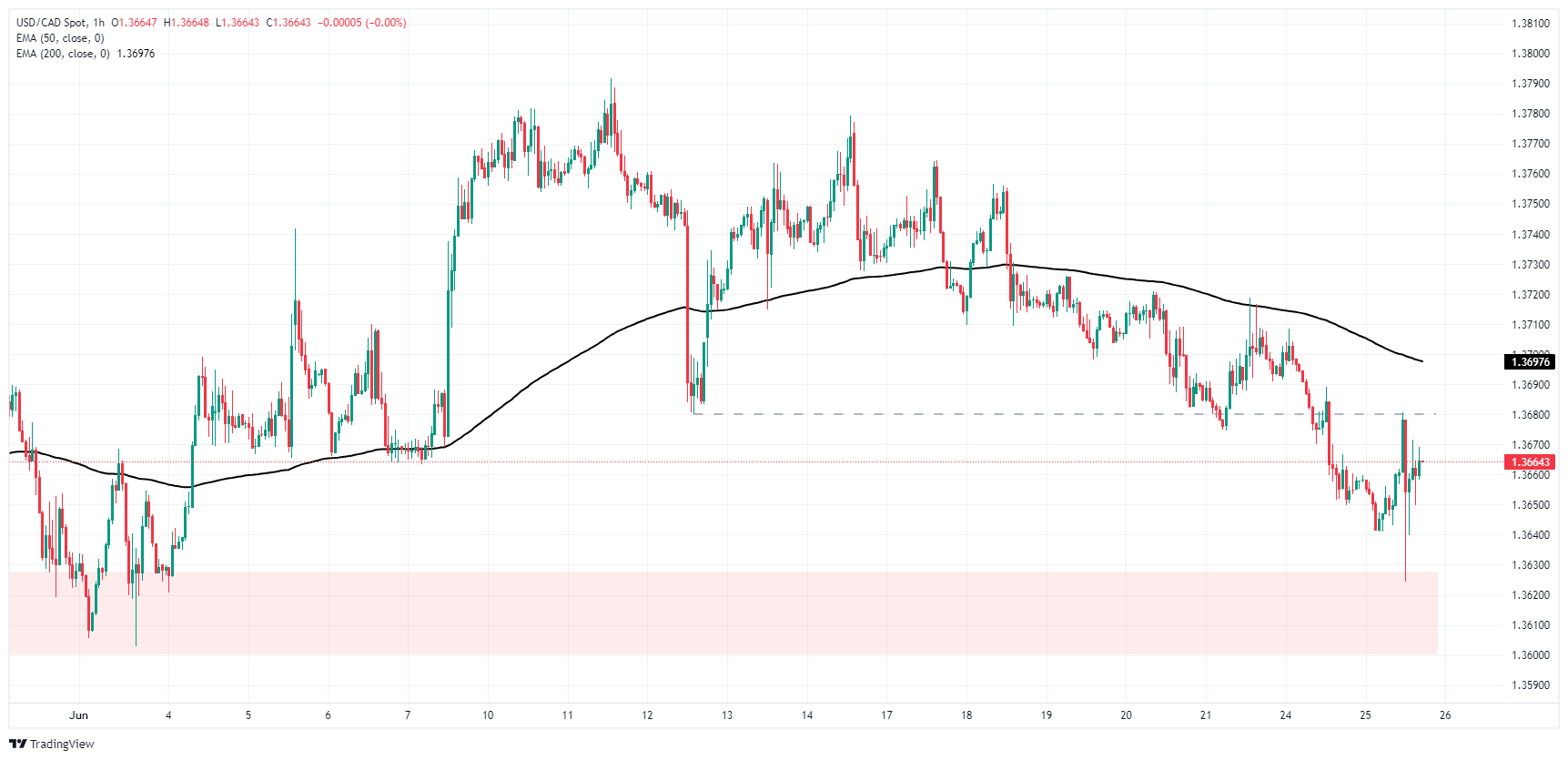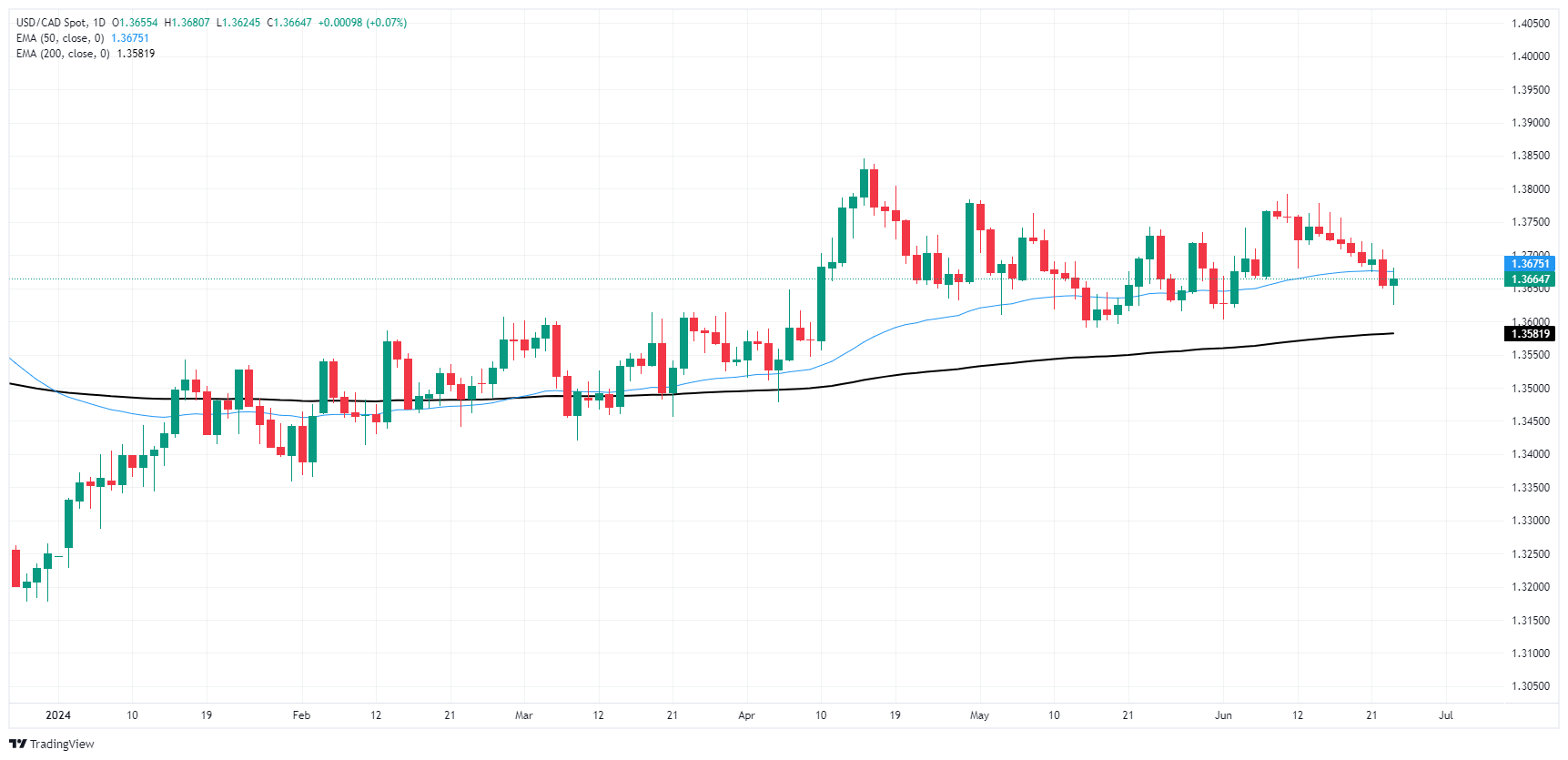Canadian Dollar roils on Tuesday after upswing in Canadian CPI inflation

- Canadian Dollar whipsaws against Greenback on CPI Tuesday.
- Canada reported an upswing in CPI inflation in May.
- Additional focus to fall on July inflation print in the runup to BoC July rate call.
The Canadian Dollar climbed on Tuesday after Canadian Consumer Price Index (CPI) inflation ticked higher in May. Despite the upswing in CPI growth, the CAD whipsawed against the US Dollar during the American market session, setting a fresh 14-day high before settling back to flat on Tuesday.
Canada also printed an upward surge in the Bank of Canada’s (BoC) CPI Core reading in May. With CPI inflation snapping higher following the BoC’s recent rate cut, renewed focus will be put on June’s upcoming CPI print ahead of the Canadian central bank’s rate call slated for July 24.
Daily digest market movers: Canadian CPI upswing sends CAD higher
- Canadian CPI inflation rose to 2.9% YoY in May, erasing the forecasted downtick to 2.6% from the previous 2.7%.
- MoM CPI climbed to 0.6% in May, coming in well above the forecast 0.3% and accelerating from the previous 0.5%.
- BoC’s own CPI Core also rose to 0.6% MoM versus the forecast hold at 0.2%.
- A snap rise in Canadian inflation follows a recent quarter-point cut from the BoC, which could spark concerns that the Canadian central bank started cutting too early.
- US CB Consumer Confidence survey eased to 100.4 from 102.0, a slightly better print than the expected 100.0.
Canadian Dollar PRICE Today
The table below shows the percentage change of Canadian Dollar (CAD) against listed major currencies today. Canadian Dollar was the strongest against the Euro.
| USD | EUR | GBP | JPY | CAD | AUD | NZD | CHF | |
|---|---|---|---|---|---|---|---|---|
| USD | 0.20% | -0.01% | 0.03% | 0.02% | 0.17% | 0.02% | 0.19% | |
| EUR | -0.20% | -0.21% | -0.17% | -0.19% | -0.04% | -0.12% | -0.02% | |
| GBP | 0.00% | 0.21% | 0.04% | 0.02% | 0.18% | 0.10% | 0.21% | |
| JPY | -0.03% | 0.17% | -0.04% | -0.02% | 0.15% | 0.11% | 0.18% | |
| CAD | -0.02% | 0.19% | -0.02% | 0.02% | 0.14% | 0.07% | 0.19% | |
| AUD | -0.17% | 0.04% | -0.18% | -0.15% | -0.14% | -0.08% | 0.04% | |
| NZD | -0.02% | 0.12% | -0.10% | -0.11% | -0.07% | 0.08% | 0.11% | |
| CHF | -0.19% | 0.02% | -0.21% | -0.18% | -0.19% | -0.04% | -0.11% |
The heat map shows percentage changes of major currencies against each other. The base currency is picked from the left column, while the quote currency is picked from the top row. For example, if you pick the Canadian Dollar from the left column and move along the horizontal line to the US Dollar, the percentage change displayed in the box will represent CAD (base)/USD (quote).
Technical analysis: Canadian Dollar gains some ground amid churn, but gains remain tepid
The Canadian Dollar (CAD) briefly rose to a fresh two-week high against the US Dollar on Tuesday before falling back within the day’s opening range. The CAD also eked out gains against the Euro and the Australian Dollar, climbing around one-fifth of one percent against each.
USD/CAD tumbled to a new 14-day low of 1.3624 before snapping back to Tuesday’s opening bids near 1.3660. The pair is caught in near-term chart churn as bidders struggle to break through intraday technical resistance at 1.3680.
Despite grinding out a -1.2% decline top-to-bottom from early June’s peak at 1.3791, the CAD looks set to run out of gas against the US Dollar with USD/CAD finding a price floor near 1.3650. Daily candles continue to tread water in a consolidation pattern north of the 200-day Exponential Moving Average (EMA) at 1.3582.
USD/CAD hourly chart
USD/CAD daily chart
Canadian Dollar FAQs
The key factors driving the Canadian Dollar (CAD) are the level of interest rates set by the Bank of Canada (BoC), the price of Oil, Canada’s largest export, the health of its economy, inflation and the Trade Balance, which is the difference between the value of Canada’s exports versus its imports. Other factors include market sentiment – whether investors are taking on more risky assets (risk-on) or seeking safe-havens (risk-off) – with risk-on being CAD-positive. As its largest trading partner, the health of the US economy is also a key factor influencing the Canadian Dollar.
The Bank of Canada (BoC) has a significant influence on the Canadian Dollar by setting the level of interest rates that banks can lend to one another. This influences the level of interest rates for everyone. The main goal of the BoC is to maintain inflation at 1-3% by adjusting interest rates up or down. Relatively higher interest rates tend to be positive for the CAD. The Bank of Canada can also use quantitative easing and tightening to influence credit conditions, with the former CAD-negative and the latter CAD-positive.
The price of Oil is a key factor impacting the value of the Canadian Dollar. Petroleum is Canada’s biggest export, so Oil price tends to have an immediate impact on the CAD value. Generally, if Oil price rises CAD also goes up, as aggregate demand for the currency increases. The opposite is the case if the price of Oil falls. Higher Oil prices also tend to result in a greater likelihood of a positive Trade Balance, which is also supportive of the CAD.
While inflation had always traditionally been thought of as a negative factor for a currency since it lowers the value of money, the opposite has actually been the case in modern times with the relaxation of cross-border capital controls. Higher inflation tends to lead central banks to put up interest rates which attracts more capital inflows from global investors seeking a lucrative place to keep their money. This increases demand for the local currency, which in Canada’s case is the Canadian Dollar.
Macroeconomic data releases gauge the health of the economy and can have an impact on the Canadian Dollar. Indicators such as GDP, Manufacturing and Services PMIs, employment, and consumer sentiment surveys can all influence the direction of the CAD. A strong economy is good for the Canadian Dollar. Not only does it attract more foreign investment but it may encourage the Bank of Canada to put up interest rates, leading to a stronger currency. If economic data is weak, however, the CAD is likely to fall.
